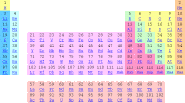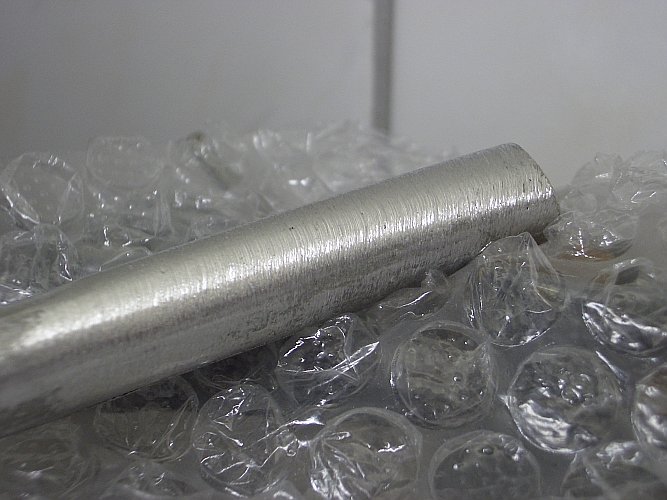


Cadmium
 The metal cadmium resembles the metal zinc quite a lot,
both in appearance and in chemical properties. The metal is somewhat less
electropositive than zinc, but it also tarnishes in air and also dissolves
easily in non-oxidizing acids with formation of hydrogen.
The metal cadmium resembles the metal zinc quite a lot,
both in appearance and in chemical properties. The metal is somewhat less
electropositive than zinc, but it also tarnishes in air and also dissolves
easily in non-oxidizing acids with formation of hydrogen.
Compounds of cadmium have a somewhat more covalent character than the corresponding compounds of zinc. E.g. compounds like cadmium bromide and cadmium iodide hardly dissociate into their ions, when dissolved in water.
An important difference between zinc and cadmium is that the latter is much more toxic to humans and to the environment. The use of cadmium and its compounds is banned in most industrialized countries, due to its toxicity.
Cadmium can be purchased on eBay frequently for a very reasonable price and at very high purity. For the home chemist, cadmium is not the first element to play with, but it has some interesting properties, especially in its potential to form beautifully colored precipitates.
![]()
In its compounds, cadmium has the +2 oxidation state, just like zinc. The free cadmium ion is colorless. Cadmium ion has a strong tendency to hydrolyse. Compounds of cadmium resemble the similar compounds of zinc, but they usually have a more covalent character. Some compounds of cadmium, available to the public are the following:
- cadmium sulfide, CdS
- cadmium selenide, CdSe
- cadmium bromide, CdBr2
- cadmium iodide, CdI2
Although cadmium compounds are available for the public, it is better not to experiment with them. They only have limited interesting properties. Combining this with the toxicity of cadmium, it is best not to play with them. For experimenting one can better start with the metal itself and prepare solutions, containing cadmium ions, by means of dissolving some of the metal in a dilute mineral acid.
![]() If
one really wants to experiment with cadmium compounds, then the best option is
to use cadmium sulfide. This is a bright yellow compound, available from art and
paint shops as the pigment cadmium yellow. Sometimes more 'cadmium yellow'
pigments are offered. The brightest yellow compound should be used. Lighter
compounds frequently are cadmium sulfide, mixed with zinc sulfide or with barium
sulfate. When the bright yellow compound is added to dilute hydrochloric acid
(approximately 10% HCl), then it dissolves, while producing hydrogen sulfide.
When the liquid is heated somewhat, then the hydrogen sulfide is driven off and
the cadmium ions remain in solution. This must be done outside, due to toxicity
of hydrogen sulfide. The remaining solution is clear and colorless. When the
hydrogen sulfide is not driven off very well, then on dilution, the liquid will
become yellow and turbid again, due to back-formation of cadmium sulfide from
the free cadmium ions and remaining hydrogen sulfide.
If
one really wants to experiment with cadmium compounds, then the best option is
to use cadmium sulfide. This is a bright yellow compound, available from art and
paint shops as the pigment cadmium yellow. Sometimes more 'cadmium yellow'
pigments are offered. The brightest yellow compound should be used. Lighter
compounds frequently are cadmium sulfide, mixed with zinc sulfide or with barium
sulfate. When the bright yellow compound is added to dilute hydrochloric acid
(approximately 10% HCl), then it dissolves, while producing hydrogen sulfide.
When the liquid is heated somewhat, then the hydrogen sulfide is driven off and
the cadmium ions remain in solution. This must be done outside, due to toxicity
of hydrogen sulfide. The remaining solution is clear and colorless. When the
hydrogen sulfide is not driven off very well, then on dilution, the liquid will
become yellow and turbid again, due to back-formation of cadmium sulfide from
the free cadmium ions and remaining hydrogen sulfide.
![]() The
compound cadmium selenide is a dark red compound, available from art and paint
shops as the pigment 'cadmium red'. Again, there are several shades of red,
ranging from orange-red to dark red/brown. The darkest available cadmium red
should be taken. Cadmium reds have composition CdSxSe1-x,
with 0 < x < 1. The larger x, the lighter the color. For home chemistry
experiments, where one is interested in cadmium chemistry, the use of cadmium
red is strongly advised against. In order to release the cadmium, the selenium
has to be driven off as hydrogen selenide.
The
compound cadmium selenide is a dark red compound, available from art and paint
shops as the pigment 'cadmium red'. Again, there are several shades of red,
ranging from orange-red to dark red/brown. The darkest available cadmium red
should be taken. Cadmium reds have composition CdSxSe1-x,
with 0 < x < 1. The larger x, the lighter the color. For home chemistry
experiments, where one is interested in cadmium chemistry, the use of cadmium
red is strongly advised against. In order to release the cadmium, the selenium
has to be driven off as hydrogen selenide.
![]()
![]() Do not do
that at home, not even outside, see page on selenium.
Do not do
that at home, not even outside, see page on selenium.
![]() Cadmium bromide is a white to slightly yellow powder. It is soluble in water.
Solutions of this are only partially dissociated into cadmium and bromide ions.
When one wants to experiment with cadmium salts, then this is not the compound
to start with. The presence of the bromide counter-ion may strongly interfere
with many experiments. Cadmium bromide is available from a few photography raw
chemical suppliers. It is quite expensive.
Cadmium bromide is a white to slightly yellow powder. It is soluble in water.
Solutions of this are only partially dissociated into cadmium and bromide ions.
When one wants to experiment with cadmium salts, then this is not the compound
to start with. The presence of the bromide counter-ion may strongly interfere
with many experiments. Cadmium bromide is available from a few photography raw
chemical suppliers. It is quite expensive.
![]() Cadmium iodide also is a white to slightly yellow powder. It resembles cadmium
bromide quite a lot. It is even less ionized than cadmium bromide, when it is
dissolved in water.
When one wants to experiment with cadmium salts, then again this is not the compound
to start with. The presence of the iodide counter-ion even interferes more strongly
than the presence of bromide ion in many experiments. Cadmium iodide also is available from a few photography raw
chemical suppliers. It also is quite expensive.
Cadmium iodide also is a white to slightly yellow powder. It resembles cadmium
bromide quite a lot. It is even less ionized than cadmium bromide, when it is
dissolved in water.
When one wants to experiment with cadmium salts, then again this is not the compound
to start with. The presence of the iodide counter-ion even interferes more strongly
than the presence of bromide ion in many experiments. Cadmium iodide also is available from a few photography raw
chemical suppliers. It also is quite expensive.

![]() Compounds of
cadmium are toxic. When experiments are conducted with cadmium, cadmium sulfide
or solutions prepared with this, be sure not to breathe any fine particles or
droplets of the (heated) solutions. Cadmium waste definitely must be brought
to a proper waste processing facility.
Compounds of
cadmium are toxic. When experiments are conducted with cadmium, cadmium sulfide
or solutions prepared with this, be sure not to breathe any fine particles or
droplets of the (heated) solutions. Cadmium waste definitely must be brought
to a proper waste processing facility.